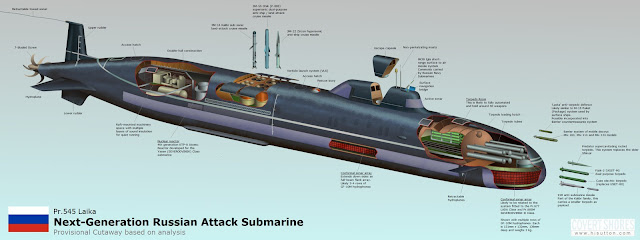Laika class - use and purpose in the Russian Navy
The project 545 Laika class nuclear attack submarine was first announced on a Russian Defense exhibition in December 2019. Although the submarine was not officially confirmed as the newest class in the Russian nuclear submarine fleet, many analysts have speculated over the use and purpose of the Laika class in the Russian Navy. The Laika class is speculated to be a cheaper alternative to the Project Pr.885/885M Severodvinsk class submarine (NATO reporting name ‘Yasen’). Rather than being a direct competitor to Severodvinsk class, the Laika class is considered to operate in conjunction with the Severodvinsk class. Being a cheaper brother to the Severodvinsk class, the Laika will most likely be used to replace the existing fleet of Russian nuclear attack submarines such as the Project 945 Barrakuda and Project 945A Kondor, (NATO reporting names 'Sierra I’ and ‘Sierra II’ respectively) and Project 971 Shchuka-B (Nato reporting name ‘Akula’) classes.
 |
| Laika class submarine - image copyright by H I Sutton |
This diversification of the Russian nuclear submarine fleet comes as no surprise as both the Soviet and Russian navies developed submarines build around a specific task. This is unlike most western navies who develop and build nuclear attack submarines designed to take on a wide arrange of roles and tasks. Building submarines for specific tactical purposes, rather then an all-round design, is a natural extension of the current naval doctrine in use by the Russian Navy.
The main opponent for the Russian Navy will be the US Navy and more specific the US Navy carrier battle groups operating in the Atlantic and Pacific Oceans. The Severodvinsk class will replace the Oscar-II class whose task it was to strike carrier battle groups with anti-ship missiles. As such, the Severodvinsk class is expected to be the main strike weapon against US carrier battle groups. In order to succeed in her mission she has to overcome the anti-submarine and air-defenses of the carrier battle group. As such she is need of operating the latest electronics to detect and counter enemy submarines as well as the most modern generation of missiles such as Kalibr, Oniks and Tsirkon. All this makes the Severodvinsk an expensive platform which limits the amount of submarines the Russian Navy can build. The Severodvinsk class can not be build in sufficient numbers in order to replace the remaining Russian attack submarines.
 |
| Severodvinsk class - Copyright by H I Sutton |
Being a cheaper version of the Severodvinsk, the Laika class can be constructed in higher numbers in order to replace the Project 945 and 971 submarines. Her cheaper design however comes with some drawbacks which limits her effectiveness. The most prominent is the absence of a pump-jet. The Laika class will use a conventional screw for propulsion instead of a more quieter pump-jet used on the Severodvinsk class. She will however maintain the double hull design from the Shchuka-B class which increases her survivability. Although the torpedo room is believed to be of a similar design as the Shchuka-B class, the Laika class will reportedly carry four silos for cruise missiles, allowing her to carry 16 missiles. This setup allows the Laika class to successfully engage surface warships but with just 16 missiles she will be restricted to attacking single warships or smaller task forces.
Though cheaper, a bit noisier and limited in launching cruise missiles compared to the Severodvisnk class, the Laika class nevertheless has a place in Russian Navy doctrine. Unlike US attack submarines, who operate all over the world, Russian attack submarines are tasked to defend bastion areas near naval bases and protect the ballistic missile submarines. Rather than being a blue ocean force, Russian attack submarines operate more in the littoral zone and restrict themselves to be a green water force. Operating in the bastion zones also means that the Laika submarines can be supported by maritime aviation and surface task forces instead of being a lone hunter on the world oceans.
The remaining question however is the practicality of having two types of attack submarines in service. Both submarines are developed by the same design bureau, namely Malachite design bureau. As such we can expect that both submarines share much of the same technology and components. This could allow for a form of standardisation whereby spare parts for the Severodvinsk class could be used for the Laika class. Subsequently, this results in a lower cost for construction and maintenance as parts are interchangeable and technical procedures can be streamlined. Currently the Russian Navy operates several types of submarines of different designs which makes maintenance expensive. reducing the amount of classes to the bare minimum according to doctrinal needs can result in a Russian nuclear submarine forces that is less expensive to maintain. In turn, this results in budget being freed up to support other projects in the Russian armed forces.

